b. Shower-valve arrangement capable of scalding
For design information on pool linings refer to TB MED
(central automatic mixing valve is best).
575.
c. Caking soap or leaking soap dispenser.
d. Abrupt changes in the slope of the pool floor or
2-10. POOL
LIGHTING.
underwater steps.
Proper pool lighting not only enhances the appearance of
e. Insufficient depth or area for diving.
the pool area, but also provides necessary illumination
f. Excessively high, shakey, or slippery diving
for safety. Arrangement and design of lighting should be
equipment.
such that all surface and bottom areas of the pool,
g. Lack of water depth markings.
springboards, towers, floors, and other appurtenances
h. Turbid water (the bottom at the deepest point
are clearly visible to the lifeguards. Lights within
should be easily visible from the pool edge).
sidewalks must be protected and recessed to prevent
i. Pool drains, outlets, or other fixtures which could
tampering or breakage. Underwater lights must be
hold a person underwater.
grounded and installed so as to prevent hazards to
j. Electrical equipment capable of shocking (e.g.,
bathers. Electrical safety requirements are stated in
underwater light fixtures must be grounded).
article 680 of the 1981 National Electrical Code and have
k. Water slides poorly located, causing "traffic"
been made more stringent than previous requirements.
congestion.
Therefore, pool facilities constructed prior to this may not
l. Projecting or ungrated pipes.
meet minimum electrical safety standards. Underwater
m. Improperly vented chlorinators.
lighting and electrical out- lets in the pool area should be
n. Use of glass containers of any type in the pool
examined to insure that they comply with current
area.
requirements for ground fault protection and distance
(clearance). In general, it is good practice to remove all
2-13.
LIFESAVING FACILITIES.
unnecessary electrical equipment in the pool area and
Equally as important as preventing accidents is being
maintain the essential equipment in accordance with the
prepared to quickly and effectively respond to an
National Electrical Code.
accident. Preparedness includes the following items:
2-11.
ACCIDENT PREVENTION.
a Lifeguards: A qualified lifeguard having a valid
Accidents and drowning deaths are the most serious
American Red Cross Senior Certificate or equivalent
problems in the control of swimming pools. Lack of
should always be on duty when the pool is in use and
effective bather supervision, poor construction, and
should be positioned to observe the entire swimming
improper operation and maintenance of equipment are
area.
prime causes of such casualties. A regular routine
b Lifesaving Equipment: Swimming pools should
should be established for daily inspection of the pool
be furnished with the following lifesaving equip- ment: (a)
area and all pool equipment. The cracking or flaking of
a pole, greater in length than one-half the swimming pool
concrete can be hazardous to bathers and should be re-
width, capable of extension to all sec- tions of the floor of
paired as soon as possible. Pool ladders, diving board
the pool, constructed of suitable lightweight material and
supports, diving towers, and lifeguard chairs should be
having a life hook (shepherd’s crook) at the end with an
aperture of at least 18
2-2
TM 5-662
inches between the tip of the hook and the tip of the pole;
2-14.
FIRST AID.
(b) a-"flutter board," approximately 1 foot by 3 feet by 3
The following first aid techniques are most often used to
inches, capable of supporting in water a weight of not
revive drowning victims:
less than 20 pounds; with 3/16-inch lines attached at
a. Mouth-to-Mouth Resuscitation: Mouth-to-Mouth
least equal in length to the maximum width of the pool;
resuscitation is the most effective and easily
and (d) a separate throwing rope with a length not less
administered form of artificial respiration with which all
than one-half the maximum width of the pool.
These
pool operating personnel should be familiar. Procedures
items should be furnished on the basis of one each for
for administering mouth-to-mouth resuscitation are
every 2,000 square feet of pool surface area (see figure
explained in detail and illustrated in TM 5-682.
2.1). Elevated lifeguard platforms or chairs should also
b. Artificial Respiration: Artificial respiration by
be furnished on the basis of one per 2,000 square feet of
mechanical means (oxygen inhalers) is authorized only if
pool area.
properly trained operators are available to use the
equipment.
c. Location of Equipment: Lifesaving equipment
c. CPR (Cardio-Pulmonary Resuscitation): Cardio-
should be conspicuously displayed and strategically
pulmonary resuscitation is a lifesaving technique that
located around the pool deck or at lifeguard chairs. The
combines mouth-to-mouth resuscitation with external
equipment must be readily accessible, kept in good re-
cardiac compression to restore breathing and heart-
pair, and the function of each item marked. Bathers or
beat. This technique should not be attempted unless
other unauthorized personnel must not be permitted to
administering personnel have been properly trained.
tamper with or use the equipment for any purpose other
Proper training requires annual certification.
than its intended use.
2-3
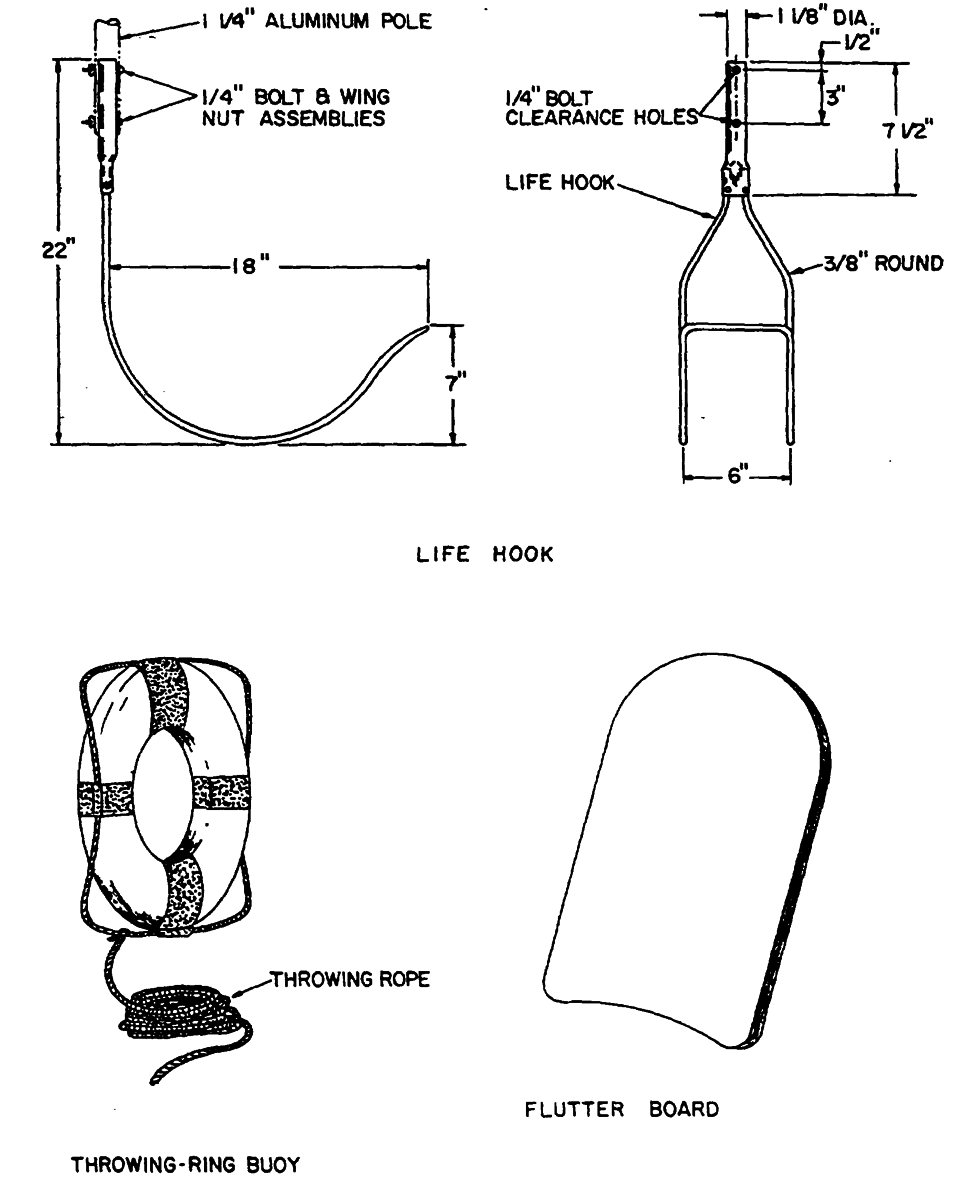
TM 5-662
Figure 2-1. Lifesaving Equipment
2-4
TM 5-662
CHAPTER 3
TYPES OF POOLS
3-1.
GENERAL.
wall. The trenches are covered with metal gratings or tile
with drain openings. The deck and the pool edge are
The location, terrain, climate, source of water, and
sloped toward the perimeter drains. The deck can be
intended use determine the type of pool constructed.
easily cleaned, but care should be taken that any
cleaning detergents used do not cause problems such as
3-2.
FILL-AND-DRAW AND FLOW-THROUGH
foaming in the recirculation system. (See figure 3-3.).
POOLS.
3-6.
SURFACE SKIMMERS.
Fill-and-draw and flow-through pools which do not filter
and recirculate the water are not approved for use at
Surface skimmers are slots constructed in the wall of the
military installations.
pool at regular intervals of 15 to 25 feet. Within each
wall opening there are floating weirs that control the
3-3.
RECIRCULATING POOLS.
water overflow. Surface skimmers allow about 6 inches
a. Recirculating pools are pools in which the water
between the water level and the deck level. Each
is constantly pumped from the pool, filtered, disinfected,
overflow weir usually discharges into a cylindrical
and pumped back into the pool. Water is added as
opening that has an access cover at the deck level and a
needed to make up for losses due to evaporation,
pipe at the bottom to drain the pool overflow to the
leakage, and water discharged to waste through overflow
recirculation system. A removable leaf-strainer basket
troughs. This is the most sanitary and economical type
fits in the bottom of this overflow receiver. (See figure 3-
of pool and is the type approved for use at military
3.) .
installations. (See figures 3-1 and 3-2.)
b. The basic differences in recirculating pools,
3-7.
WADING POOLS.
other than sizes and shapes, are in the perimeter
overflow systems. The primary purpose of a pool
A wading pool is a shallow pool (usually 6 to 24 inches in
overflow system is to provide a continuous skimming of
depth) intended for use by children. Health hazards due
the water surface. Overflow occurs as filtered water is
to contamination are much greater in children’s pools
added and as water is displaced by swimmers. This
than in adult pools because of the unavoidable habits of
displaced water, containing much of the debris and other
small children. Because the quantity of water is small
wastes, is usually returned through gutter drains to the
and a considerable amount of debris is often carried into
filters; however, in some pools, the water is wasted. In
the pool, wading pools require frequent draining and
some pools all the water recirculated through the filters is
cleaning. Wading pools should have a continuous flow
taken from the overflow system. In other pools, some or
of treated water providing a complete change of water
all of the recirculated water is taken from the main drain
every two hours.
at the bottom of the pool. Pool overflow systems can be
separated into the following three general categories:
3-8.
TYPES OF WADING POOLS.
3-4.
TROUGH OR GUTTER TYPE.
Wading pools, like regular swimming pools, can be
classified as flow-through, fill-and-draw, or recirculation
Continuous gutters or troughs are constructed around
type. The newest and most sanitary type of children’s
the inside walls of the pool, either fully or partially
pool is the spray pool. Fresh or treated water is sprayed
recessed, or at the top of the wall in an open position
through a nearly vertical nozzle atop a 3 to 5 foot high
(often called roll-out type gutters). (See figure 3-3.).
pipe positioned near the center of the pool. By regulating
the water pressure, all the sprayed water falls into the
3-5.
RIM FLOW TYPE.
pool. A drain at the low point of the pool continuously
discharges water to waste; therefore, no water
This type of perimeter overflow system maintains the
accumulates in the wading pools. The conversion of
water at the level of the surrounding deck. No overflow
wading pools to spray pools, which is comparatively
troughs are used. Trenches are constructed in the deck
easy, is highly recommended. (See figure 3-4.)
surrounding the pool and adjacent to the pool
3-1
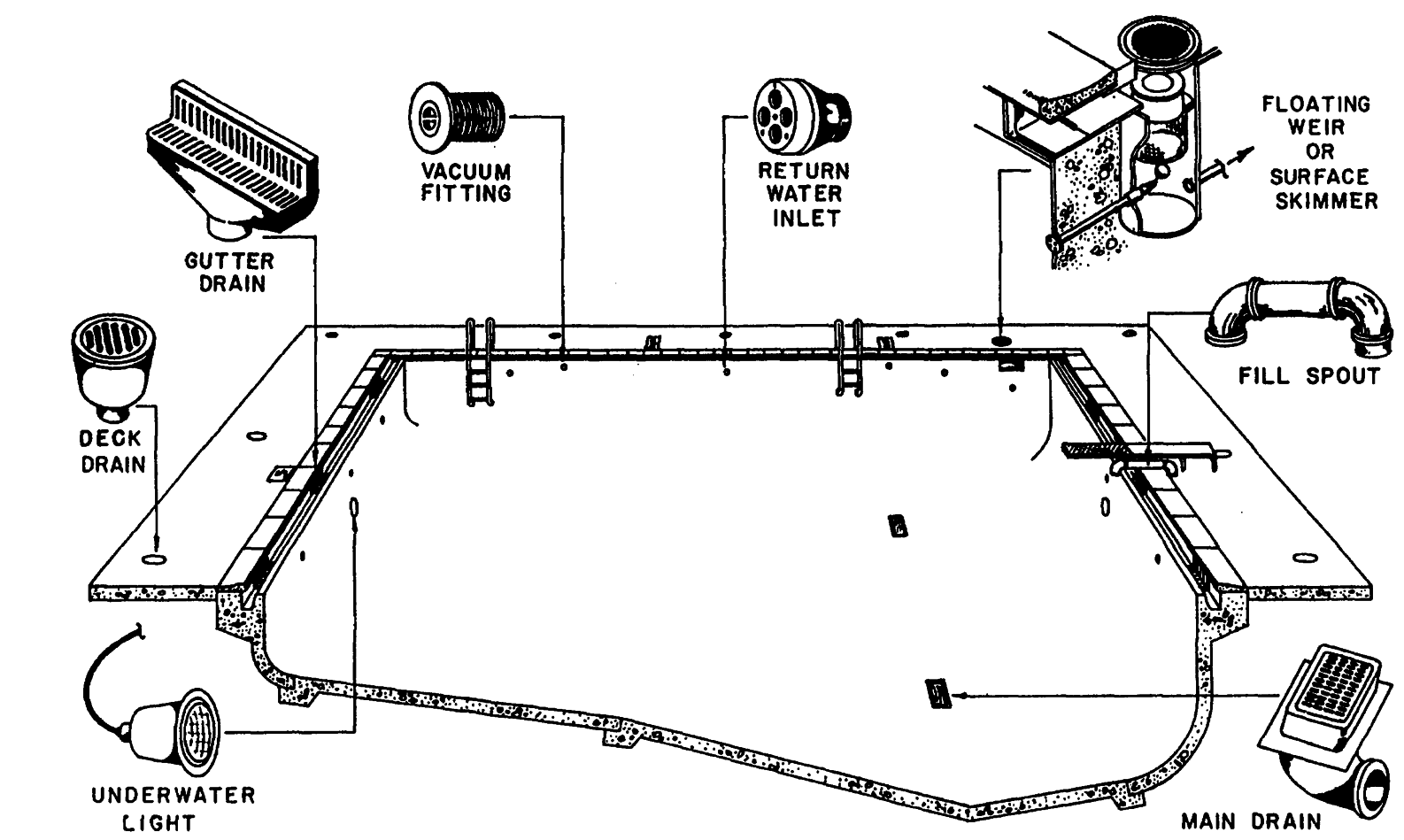
TM 5-662
Figure 3-1. Longitudinal section through pool, showing fittings.
3-2
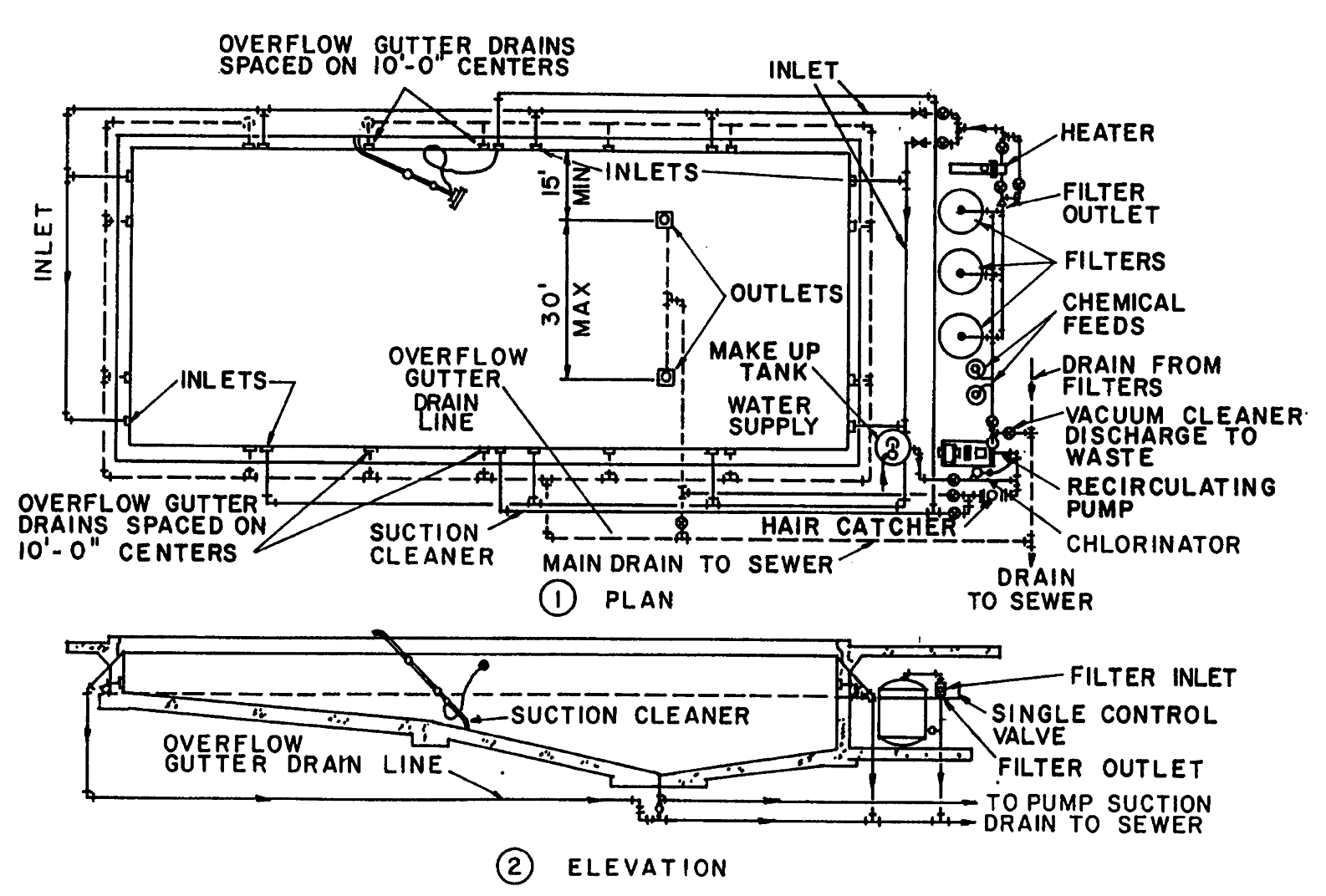
TM 5-662
Figure 3-2. Typical recirculation pool and equipment.
3-3
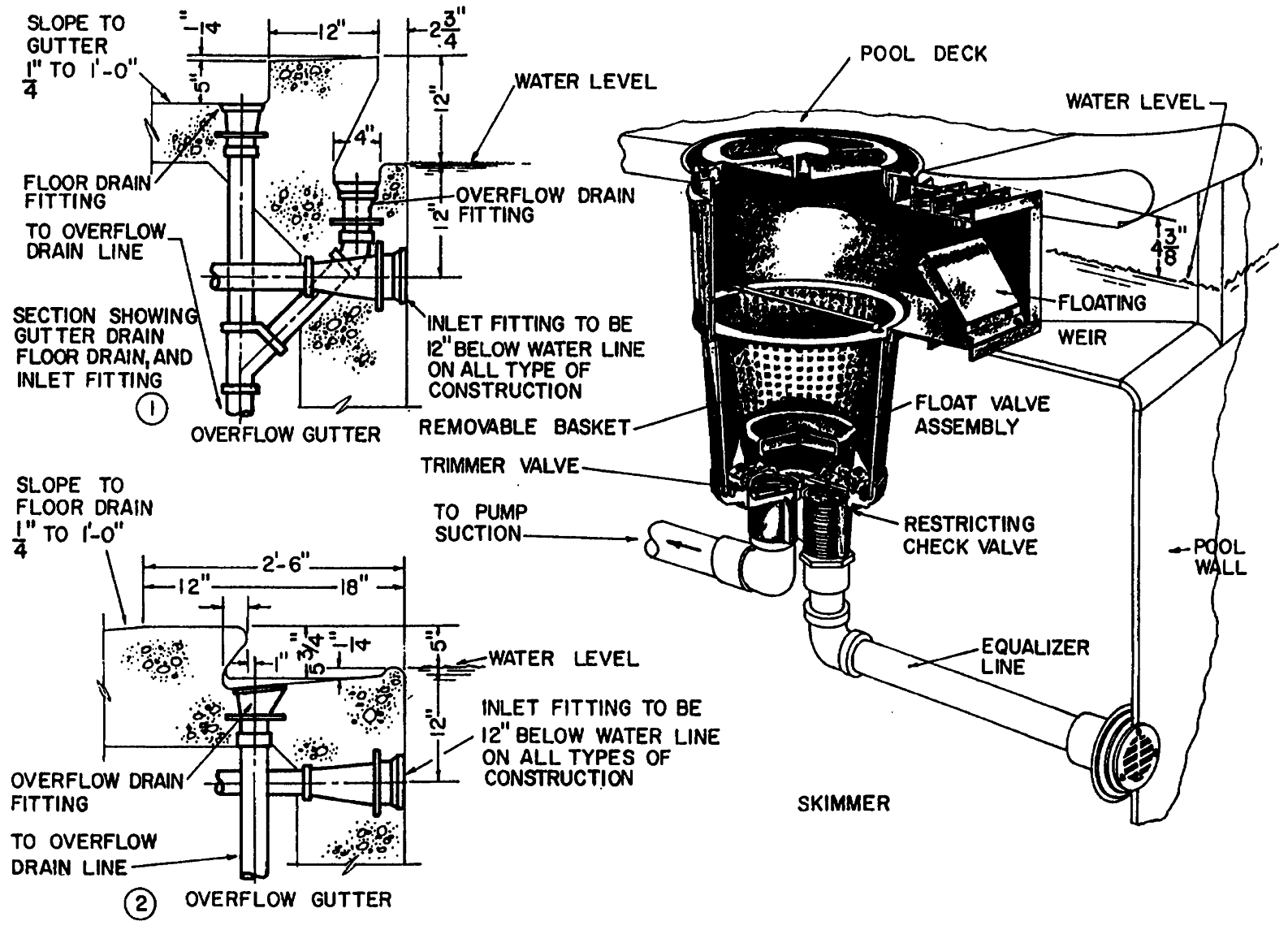
TM 5-662
Figure 3-3. Overflow and skimmer.
3-4
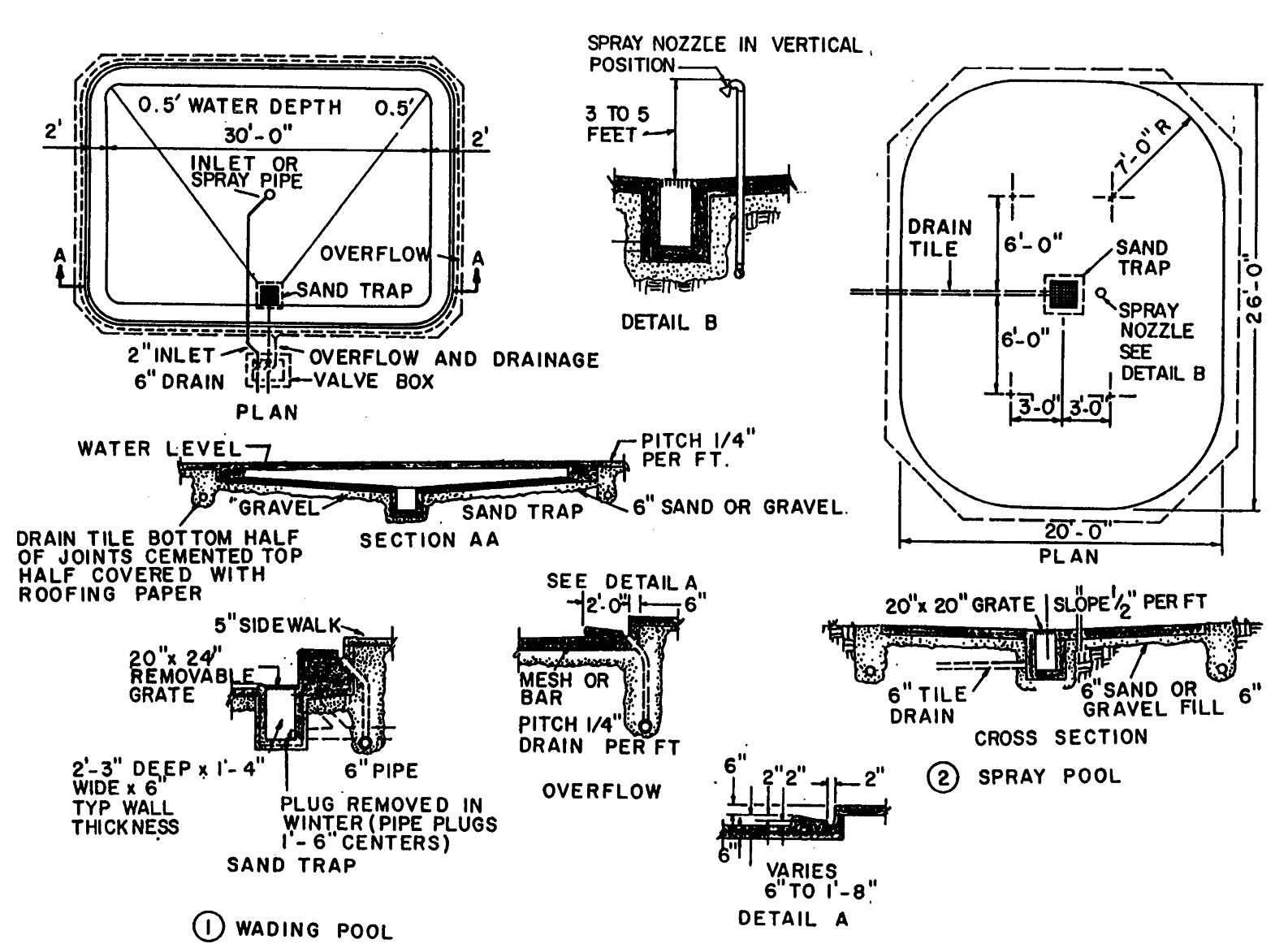
TM 5-662
Figure 3-4. Typical children’s pools
3-5
TM 5-662
CHAPTER 4
STANDARDS
4-1.
PERSONNEL.
number of pool users and operation and maintenance
duties.
Personnel hired to perform the various types of pool
maintenance, operation, and lifeguard duties must have
4-4.
HOUSEKEEPING.
evidence of proper training or qualifications.
High maintenance standards will insure the safe and
4-2.
QUALITY OF SWIMMING POOL WATER.
economical operation of an entire pool area. The first
step in maintaining a clean pool is to prevent foreign
Disinfection of swimming pool water is achieved by
matter from entering the pool. Floating debris is easily
maintaining a bactericidal concentration of chlorine
disposed of by keeping water levels high enough to
distributed uniformly throughout the pool. Methods of
maintain a constant overflow into the troughs and weirs.
applying disinfectants and tests for determining residual
Allowing the water level to drop prevents proper disposal
concentrations are outlined in TB MED 575 and TM 5-
of floating debris and also causes a scum ring to form
660. Chlorine residuals and corresponding pH values for
around the pool. Sediment and debris deposits on the
optimum bactericidal action and minimum eye irritations
bottom of the pool should be removed daily with suction
are given in Appendix B. Laboratory examinations for equipment and discharged to waste.
determining total bacteria count and numbers of the
coliform group are as outlined in "Standard Methods for
Normally, it is not necessary to empty a properly
Examination of Water and Wastewater," latest edition.
operated recirculating pool for cleaning.
Not more than 15 percent of the samples examined
during any 30-day period may contain more than 200
4-5.
SANITATION.
MPN bacteria per milliliter (ml) or not more than 15
percent of the samples may show positive (confirmed)
Sand, grass, leaves, dust, and other foreign matter may
test for coliform organisms in any of the five 10 ml
be tracked into the pool by bathers or blown in by the
portions comprising each sample. When the membrane
wind. To minimize this, direct access to the pool area
filter procedure is used, not more than 15 percent of the
should be prevented by routine bathers through foot
membrane filters may show more than 1.0 coliform
sprays or showers. Also persons wearing shoes should
organism per 50 ml.
not be allowed on the pool deck. Pool walkways and
decks must be kept thoroughly clean to maintain
4-3.
WORK SCHEDULE.
sanitation and prevent accidents. Cracks and low spots
in the pool deck should be promptly repaired.
Work schedules are established contingent on the
4-1
TM 5-662
CHAPTER 5
PRINCIPLES OF POOL OPERATION
5-1.
PATRON SANITATION.
gether to accomplish the ultimate goal of safe, clear pool
water. In subsequent chapters they are discussed
Pool sanitation begins with bather supervision and
individually to provide the reader with detailed knowledge
discipline. For the most part, the rules governing good
of how each system performs.
conduct and cleanliness are fairly uniform as published
in various pool operations publications and as posted on
5-5.
RECIRCULATION.
walls and fences of public pools throughout the United
States. Unfortunately, however, the seriousness of
a. The function of the swimming pool recirculation
enforcing the rules is not stressed. Not until the pool
system is probably best described as a type of
operator understands the public health involvement can
transportation system. Water is transferred from the
he/she fully appreciate the importance of enforcing every
pool, delivered to a station where it is filtered and
rule without exception.
chemically treated, and then returned to the pool. The
round trip the water takes is described by the term
5-2.
BODILY INFECTION.
"turnover." Turnover is expressed as the number of
hours necessary to circulate a volume of water equal to
An obviously healthy patron wearing a small bandage
the volume contained in the pool. Another method of
may appear entirely harmless to an untrained bathhouse
expression is the number of times in 24 hours that the
attendant. However, the bandage may be covering a
volume of the pool is circulated; i.e., turnover in 8 hours
common pimple or sore, that has festered with
is a turnover of three.
staphylcoccus bacteria. Although the highly localized
b. Both in theory and practice, it has been
infection presents no serious problem for the person
determined that the typical public pool should be
afflicted, it does pose a significant health hazard if these
recirculated continuously at a rate equal to one turnover
same bacteria are washed from the infection and
in each 6to 8-hour period. The Law of Dilution as
conveyed to other bathers.
developed by Gage and Bidwell suggests that such a
turnover rate will provide 95 percent to 98 percent
5-3.
SHOWERING AND EATING.
dilution of soiled pool water with water that has been
filtered and chemically treated. Gage and Bidwell’s law
Much more difficult to relate to public health are the rules
has been largely upheld in practice, and the 6to 8-hour
that require nude showers with warm water and soap
turnover rate has generally become a standard for the
and that prevent food, drink, or tobacco in the pool area.
operation of public pools.
Permitting patrons to enter the pool unbathed can impair
the efficiency of the disinfection system by as much as
5-6.
FILTRATION.
50 percent. As indicated in discussions which follow,
Filtration is of some value for its capacity to remove
organic soil (usually harmless in itself) imposes a serious
bacteria and disease producing organisms. However, its
burden upon the chemical disinfectants and filtration
primary function is to remove soil particles which, if not
system if allowed to accumulate in the pool.
removed, would increase the need for chemical
treatment and reduce the germ killing and oxidizing
5-4.
WATER TREATMENT TECHNIQUES.
power of disinfection chemicals.
a. Since the contamination of swimming pool water
to some extent is inevitable, water treatment techniques
5-7.
DISINFECTION.
must be established to make the water safe for bathers.
a. The disinfection function is a complicated
Such treatment is accomplished by the operation of three
process involving rather intricate chemistry. Ideally,
interrelated and interacting systems:
disinfection is accomplished by introducing a germ-killing
(1)
A system for the recirculation and
chemical to pool water in sufficient strength to rapidly
distribution of pool water.
destroy bacteria. Chlorine, one of a group of chemicals
(2)
A system for feeding chemicals for
referred to as "halogens," is the disinfecting agent most
disinfection and control of pH.
commonly used in public pools and is therefore used as
(3)
A system for the removal of particles by
a term of reference henceforth in this manual.
filtration.
b. In this chapter these systems are discussed
together to emphasize the manner in which they work to-
5-1
TM 5-662
b. When chlorine is added to pool water, it
solved minerals such as calcium and iron with resulting
combines chemically with the-oxygen and hydrogen
discoloration and turbidity. Low pH can cause serious
components of water to produce hypochlorous acid
corrosive damage to metals in the recirculation system.
(HOCL) which attacks and kills bacteria.
Both high and low pH will cause eye irritation.
c. Disinfection may also be accomplished with
c. From a public health viewpoint, the most serious
bromine and the chemistry involved is much the same.
effect of improper pH control is the reduced efficiency of
The chemical reaction produces a mild acid with germ
the disinfection process. As pH rises above 8.0, chlorine
killing properties approximately equal to those of
reactions tend to produce an abundance of hypochlorite
hypochlorous acid.
ion (OCL) rather than the desired hypochlorous acid
d. Regardless of the disinfecting agent used, the
(HOCL) greatly reducing germ-killing oxidizing powers.
primary goal is the same: to provide a uniformly
Sections 6.5 discusses a procedure of super chlorination
distributed disinfection and oxidation residual of sufficient
that can be successfully used with high chlorine values
strength to rapidly destroy disease producing organisms
and high pH under careful control. Also "breakpoint"
in pool water.
chlorination, which is covered in paragraph 6.6, is
e. Although chlorination is primarily for disinfection
effective in burning out the ammonia content of the pool
to kill microorganisms, it serves another very important
water. As the pH value rises the chlorine residual
and useful purpose. The commonly used chlorine and
progressively weakens. A pH value above 8.5 makes
bromine products possess strong oxidizing properties
the chlorine virtually useless for disinfection and
which cause them to react with and destroy many foreign
oxidation purposes.
materials other than bacteria. Many of these materials, if
d. The inexperienced pool operator is often
not destroyed by oxidation, would impart undesirable
surprised to discover that serious water problems have
characteristics to the water such as turbidity, color or
developed despite the fact that filters are functioning
odor. This chemical destruction of foreign material plays
properly and chlorine residual reads strong in the
an important part in the filtration/disinfection process, as
chlorine test procedure. In such cases, the problem is
is discussed in chapter 6.
often traced to the fact that pH has been permitted to
drift well into the undesirable








